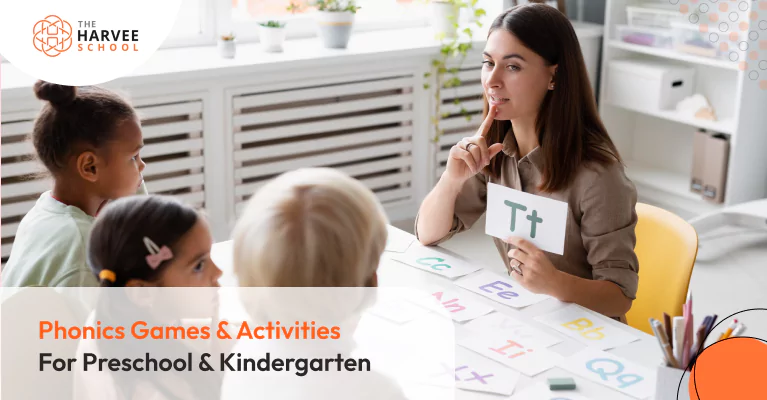Phonics Games & Activities For Preschool & Kindergarten
Early literacy should feel like play. When children clap out syllables, hop on letter mats, or “fish” for word families, they naturally connect sounds to symbols—the foundation of strong reading.
This guide collects teacher-approved phonics games & activities for preschool & kindergarten that you can set up in minutes, scale for different abilities, and weave into your daily routine.
Why Phonics-Based Play Matters?
Phonics teaches that letters and letter groups stand for specific sounds (phonemes). Research shows that playful, multisensory practice accelerates:
- Sound recognition—matching /b/ with “b” or “bb.”
- Blending & segmenting—stitching sounds into words (“c-a-t → cat”) and breaking them apart.
- Automatic decoding—reading unfamiliar words without guessing.
When lessons feel like discovery instead of drills, kids build confidence and retain skills longer.
Setting Up Your Phonics Play Corner
Before diving into the games, gather a few low-cost staples:
| Must-Have Materials | Why They Work |
| Foam or magnetic letters | Tactile, color-coded practice |
| Large floor dice & spinners | Randomize sounds and keep energy high |
| Mini whiteboards & markers | Fast, zero-waste writing surface |
| Clothespins & string | DIY word walls or matching lines |
| Beginner phonics worksheets for kindergarten | Quiet-time reinforcement |
10 Engaging Phonics Games & Activities
1. Rainbow Letter Hop
Lay colored construction-paper letters in a path. Call out a letter sound, and children jump to the matching letter on the floor while saying the letter out loud. Extend by asking them to blend three hopped-on letters into a CVC word (b-a-t).
2. Mystery Sound Box
Hide common objects (bell, spoon, pen) in a shoebox. A child shakes the box, guesses the initial sound, then checks the object. Great for phonics exercises for kindergarten focusing on beginning phonemes.
3. Puzzle Word Builders
Cut large jigsaw pieces; write onset on one piece (“st”) and rime (“-ar”) on the other. Kids connect pieces to “solve” new words.Change the letter blends each week to keep the activity new and exciting for the kids.
4. Fishing for Sounds
Make paper “fish” with letters on them and put them in a small bin or “pool.” Kids use a magnet fishing rod to catch a fish, then say a word that starts with that letter. Perfect center for small-group rotations.
5. Flashcard Relay
Divide class into two lines. Flash a card (“sh”). The first child sees a digraph, says or writes a word using it (like “ship” for “sh”), then runs to tag the next player in line. Combines movement with speed decoding.
6. Phonics Sound-Video Match
Play short video or sound clips of common words (like “sun,” “dog,” or “hat”) on a tablet or smartboard.
Kids listen carefully and choose the correct beginning or ending sound from 3–4 options shown on screen or printed cards. You can also use interactive slides with clickable letters.
This phonics game for kindergarten improves sound discrimination, builds vocabulary, and suits both group and individual play.
7. Playdough Letter Stamps
Give kids playdough and alphabet stamps. They roll the dough flat and press the stamps to form letters and simple words. This hands-on activity builds fine motor skills while helping children connect letters to sounds in a fun, sensory way.
8. Phonics Bingo
Make Bingo cards with common letter patterns like bl, st, sh, ch, -at, -op.
You say a word out loud, like “ship”. The child listens for the sound pattern (in this case, “sh”) and covers it on their card.
Whoever covers a full row first wins!
This game helps kids hear and recognize common sounds in words while having fun.
9. DIY Kindergarten Phonics Worksheets Center
Pick a few beginner phonics worksheets for kindergarten and laminate them. Kids can use dry-erase markers to trace letters, match sounds, or build simple words—then wipe and reuse. It’s a fun, mess-free way to reinforce phonics skills without wasting paper.
10. Story Dice Sound Hunt
Roll three picture dice (with images like cat, sun, and log). Ask the child to make up a short story using the pictures. Then, have them find and circle the first letter of each word (C for cat, S for sun, L for log) on a letter chart.
This simple storytelling game helps children connect sounds with letters while boosting creativity and vocabulary.
Conclusion
Phonics doesn’t require pricey kits or rigid scripts. With the ten games above, you can transform everyday items into literacy launchpads, nurturing confident readers who see letters as friends, not hurdles.
Whether you’re a teacher or a homeschool parent, use these phonics games and activities throughout the day to help young learners build strong reading skills.






